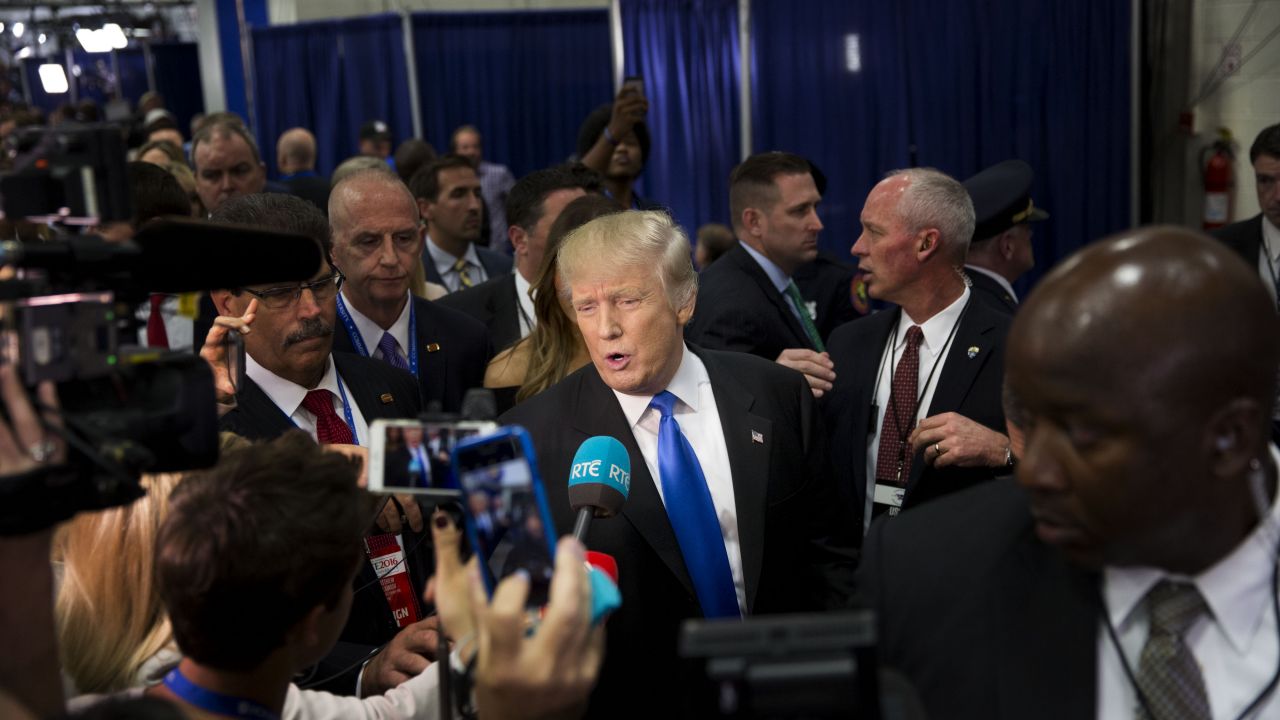
Donald Trump's love/hate relationship with the press has some First Amendment advocates worried about whether he'd try to muzzle coverage he doesn't like. (Photo by Daniel Acker/Bloomberg via Getty Images)
Could Donald Trump blow a hole in the First Amendment?
Journalists and freedom of the press experts are sufficiently concerned about the prospect that they held a panel, broadcast on C-SPAN, to consider the question on Wednesday night at the National Press Club in Washington.
The consensus: The Republican presidential nominee, who’s currently threatening a libel suit against The New York Times, would have a hard time curtailing the country’s long tradition of robust freedom of expression. But the panelists agreed the ability to fill a few Supreme Court vacancies — an opportunity that, New York Times reporter Adam Liptak noted, the next president is likely to have with the late Antonin Scalia’s post still unfilled and three of the other justices at or approaching 80 — could go a long way toward getting Trump his wish: weaker libel laws that would make it easier for public figures to bankrupt news organizations whose coverage they don’t like.
The Press Club panel was prompted by Trump’s repeated statements that he wants to revise existing libel law, which now puts the burden of proof on public figures to show “actual malice” in press coverage to win a suit. But panelists also discussed other ways the next president could restrain or intimidate journalists from providing the public with information that the next administration doesn’t want out.
— Katie Townsend, Reporters' Committee for Freedom of the Press
Anita Kumar, a White House reporter for McClatchy News Service, and Katie Townsend, a lawyer for the Reporters Committee for Freedom of the Press, both described presidential aversion to transparency as a bipartisan tendency that has tended to expand with each successive administration. “There’s a sort of secrecy creep in executive branch agencies,” said Townsend. The Reporters’ Committee was part of a media coalition that got President Barack Obama’s administration to back down from threats to prosecute reporters who published leaked information. But Townsend noted that despite Obama’s promise to provide “the most transparent administration in history,” the backlog of Freedom of Information Act requests has grown under his administration.
Given that Trump’s Democratic rival, Hillary Clinton has shown a penchant for secrecy (in addition to the contretemps about her use of a private email server while secretary of state, there’s the fact that as first lady, she worked to keep her health care strategy sessions from having to comply with the requirements of the open meetings law, noted Georgetown University professor Kenneth Jost), “President Obama is starting to look pretty good,” quipped Kumar. “Either candidate will be worse on press access,” she predicted. Neither Trump nor Clinton, she noted, has agreed to be accompanied by a “protective pool” of reporters, charged with covering important moments and sharing information with colleagues, as past presidential nominees have done.
But while a Clinton administration might represent more of the same, when it comes to journalists (and by extension, the public) scrambling for access to information, the panel suggested that Trump has issued a new level of threat — one that could jeopardize the very existence of some news organizations. Moderator Chuck Tobin, a prominent First Amendment lawyer, noted that one of the potential nominees Trump has hinted he’d choose for a Supreme Court vacancy is Peter Thiel, the Silicon Valley billionaire who helped sue the Gawker media group out of existence over stories he and wrestler Hulk Hogan didn’t like.
— Kenneth Jost, Georgetown University
Trump’s latest libel threat is over a story The Times published earlier this week, quoting two women who said the candidate earlier made improper advances. In response to Trump’s statement, The Times said stood by its story, and released a scathing letter from the newspaper’s attorney to Trump’s.
Noting that US courts have gone out of their way to protect freedom of expression, even when flagrantly offensive, ever since colonial times and the famous libel suit against printer John Peter Zenger, Jost argued that Trump is proposing to overturn more than a half-century of settled law on libel. The presumption against public figures in libel cases dates back to a landmark 1964 Supreme Court case, New York Times v. Sullivan. The author of that opinion, the late Justice William Brennan, actually wanted to ban all libel suits by public figures, Jost said, but failing to win over a majority of his colleagues to that view, instead set up the now famous “actual malice” standard for public figures to prove libel.
Jost called it “a substantial obstacle that few plaintiffs can overcome,” which is why, he suggested, Trump wants to change the law. “The horribleness of an article would have no bearing,” he said, citing one of Trump’s favorite adjectives for describing coverage he doesn’t like.
Liptak, who covers the Supreme Court for The Times, said he detects no appetite on the John Roberts court for revisiting the Sullivan decision. “This is one of those principles that’s settled and ingrained,” he said.
Still, Jost noted that presidents have tried to end around the First Amendment before. Barely more than a decade after the Constitution was ratified, he pointed out, Congress passed and President John Adams signed the infamous Alien and Sedition Acts, which led to the arrests of a number of newspaper editors, including one member of Congress. The furor led to the election of Thomas Jefferson in the election of 1800 and the repeal of the law. Panelists were skeptical that a President Trump could persuade Congress to go along with restrictions on freedom of expression. “There are lots and lots of conservatives who take a very expansive view of the First Amendment,” Liptak noted.
Short of packing the Supreme Court with justices inclined to do his bidding on libel laws, a President Trump could try to curb unwelcome coverage by freezing out reporters, the panelists conceded. Kumar noted that the practice of playing favorites in the press corps is age-old (“They all do it,” she said), but added that there are ways Trump could employ the kind of blacklisting of journalists he did during the primaries: by refusing to answer questions, by excluding them from important briefings.
That kind of retaliation can be hard to combat in the courts, said Tobin. He represented The Baltimore Sun in a case where then-Maryland Gov. Bob Ehrlich tried to keep state officials from talking to the newspaper’s reporters. The court ruled against the press.
But, Tobin added, “The footnote is that Gov. Ehrlich was defeated shortly afterward.”
A cautionary tale that reporters and First Amendment advocates clearly hope the next president will heed.




